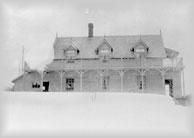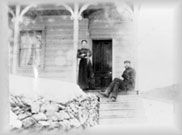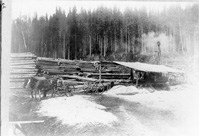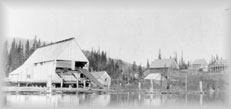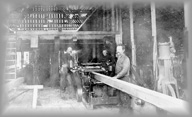 |
|
|


Although the town of Wells was not officially established until the early 1930's, there were a small number of people that lived in the area, and several buildings on the site that would later become the town of Wells. The tiny camp housed a few miners and a sawmill operation as well as Clark's stopping house20. Clarke's roadhouse or stopping house was located where the foreman's houses were built on Bowman Crescent. The nearby town of Barkerville was still inhabited, but nobody realized the changes that would occur in Wells when gold was discovered by Fred Wells.
Clarke's sawmill was one of the early landmarks of the area. It was operated for a time by the John Hopp Company and supplied timber for the firm's mines at Lowhee, Stout's Gulch and sold lumber locally. When Clarke started up his sawmill, he was the only man in charge, and he cut the timber himself. A number of other buildings soon sprung up around the mill. These included a stable and two shacks for drying lumber. Clarke also built a house with an office for himself and his family, and a large log bunkhouse.
John Peterson, an engineer and Dunc McIntyre, mill superintendent operated Clarke's steam-powered mill. Logs from the south-east side of the lake (Jack O' Clubs Lake) were floated to the north shore where they were stored until low water.
Before the Cariboo Gold Quartz Mine was established the Jack of Clubs Lake covered the entire flats and extended to the mouth of the Willow River. The mountain on the north side of the Jack of Clubs Lake was covered with very large spruce and pine trees. A 1916 forest fire destroyed this stand of trees.
Other people that lived in the area were men such as Julius Powell, who occupied a cabin at Clarke's hayfield, now the site of the Wells school.
Several miners operated in the area, two of the more well known ones were Alvin E. Sanders and Elmer Armstrong, from Oregon, who developed properties on Proserpine and Cow Mountains in 1917 known as the Rainbow Claims, at the northeast end of Jack of Clubs Lake. They eventually convinced Fred Marshall Wells to take an interest in their properties on Cow Mountain, which became the Cariboo Gold Quartz Mine, in 1927.
Peter Dunlevey was responsible for building the first stamp mill in the area in the 1880s. Dunlevey had been mining in the area since 1886. The mill was constructed with the assistance of the government of Victoria, which had offered $20,000 to the first person to erect a ten stamp mill in the Cariboo, as long as the person who was constructing the mill could put up the same amount of money. This stamping mill was built on what is now the location of Wells. Dunlevey built the mill here as it was the centre of mining activity at the time, and there was a good deal of space and available water to run the mill. Seymour Baker was the first manager of Dunlevey's stamp mill. Ore came from Burns Mountain, Jack of Clubs mine, Blackjack and many other mines in the area.
In 1902 Seymour Baker, a surveyor, purchased claims on Proserpine and Island Mountain from his employer Peter Dunlevey. In 1903 Baker established the first complete assay office and laboratory in Barkerville.
Baker believed that the future of gold recovery in the area depended upon hard rock quartz mining. After years of effort he proved his theory, and sold his property to Newmont Mines in 1933. This group of claims would later become the famous Island Mountain Mine.
Introduction | Pre Wells | Post Wells | Home | Meet the Team | Site Map
Last updated: January 26, 2001.
